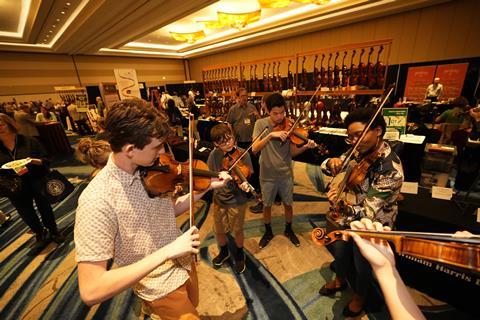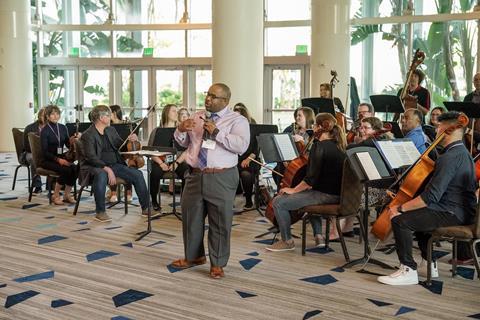The 2023 American String Teachers Association’s national conference in Orlando was defined by boundless enthusiasm and passion, as Rita Fernandes found out

Discover more Featured Stories like this in The Strad Playing Hub.
Read more premium content for subscribers here
The palm trees and swampy lands of Florida whizzed past the window on my way from Orlando airport to the hotel, and the driver wasted no opportunity to promote his home city. ‘The airport is the biggest in Florida. There are lots of national conferences here. Actually, there are volleyball championships now. You’ll see the teams at the hotel!’ It makes sense that Florida is the go-to place for national meets. Its year-round average temperature is 22 degrees, overtaking Hawaii to become the warmest US state. And there is more than enough space for gigantic hotels and convention centres – which soon appear outside the window – to host such events.
In one of these, the Hyatt Regency, the 2023 National Conference of the American String Teachers Association (ASTA) took place from 15 to 18 March. Once at the hotel, I did indeed spot a volleyball team, bubbling with excitement. What I had not imagined, however, was that this energy would be easily rivalled by the crowds of string teachers – of all ages – that assembled for the ASTA conference the next day.
During my time at the conference, it was difficult not to feel a constant fear of missing out. Not only were there twelve talks going on simultaneously, but there were also masterclasses and performances, and the exhibit hall. For the extra keen, the first day, Wednesday 15 March, included ‘pre‑conference’ activities.
On the way to these pre-conference talks, I marvelled at the scale of the place. The Floridian sun shone through windows more than ten metres high, and all types of people were hurrying to find their chosen event. My first stop was ‘Introduction to the Suzuki Method’ with James Hutchins. The talk outlined the basics of the method and its place in American string education today. At one point Hutchins encouraged attendees to share their ‘Suzuki slams’. Initially baffled by the term (and assuming it wasn’t part of Japanese vocabulary in the 1940s, when the method came into being), I eventually realised that it referred to criticisms of the Suzuki Method. Participants tentatively held up their hands to confess their struggles with it. Other topics ensued, and it became clear to me that the Americans had made the method their own. They came at it from a questioning perspective, always re-evaluating it in a contemporary light.
Read: Sphinx Organization wins inaugural ASTA Outstanding Service Organization Award
Read: Postcard from Kerteminde: Chamber Music at Lundsgaard
Discover more Featured Stories like this in The Strad Playing Hub.
Read more premium content for subscribers here
I next observed a rehearsal of the ASTA National Teachers’ Orchestra, which any teacher at the conference could sign up for. They would be performing that evening after only an afternoon’s rehearsal. The orchestra’s concertmaster, Scott Laird, began the ensemble in 2020. ‘For teachers who are now mainly teaching, this is a place to be artists again,’ he told me. The orchestra offers a supportive environment, its members are enthusiastic and Laird has a pioneering spirit just like many others I met during my visit.
The conference’s first official full day, 16 March, began with the opening ceremony at 8am (relatively late compared with the 7am start of subsequent days). ASTA president Rebecca MacLeod welcomed the large ballroom of string teachers with a confident ‘Mornin’!’ Just as she finished introducing the conference’s ‘inclusivity’ theme, she looked forward to next year’s event, announcing that for the first time it would be held concurrently with the conference of the Suzuki Association of the Americas. Then followed an awards ceremony, a keynote speech focusing on inclusivity and an impressive performance by the Howard W. Blake High School Symphonic Orchestra.
The first talk I attended that day was about how to set yourself up as a private teacher. The attendees were a mix of beginner and experienced educators, and during discussion time they not only questioned the speakers, but also shared knowledge with each other. Next was a talk by Julie Duty – one of the keynote speakers – on her organisation United Sound, whose programme integrates disabled children into the music classroom, their non-disabled peers teaching them a specially developed notation system. Again, a pioneering spirit shone through when an attendee said, ‘No school in our state has this,’ to which Duty replied, ‘Well, your school can be the first!’
I semi-jogged from talk to talk that afternoon, passing mariachi bands and teachers talking about violin technique in the hotel corridors. The day finished with a panel discussion on ‘eclectic styles’, which encompasses everything from bluegrass to rock. From the gasps as its names were announced, I gathered that the panel was a veritable who’s who of that world. They discussed the benefits of stylistic variety in teaching, including the widening of students’ horizons and the development of often-ignored skills such as improvisation. In what seemed like a deliberate repeat of what was heard in the unrelated talk hours before, an attendee said, ‘No school in my state has this,’ to which the panel, of course, answered: ‘Well, your school can be the first!’ They finished by inviting everyone to a 9.30pm jam session that evening.
I semi-jogged from talk to talk, passing mariachi bands and teachers talking about violin technique
In a world removed from eclectic styles, at 8.15am on 17 March I was listening to the United States Air Force Strolling Strings band playing songs, including themes from the 1992 film The Last of the Mohicans. To create a surround sound experience, half the ensemble walked from the back of the room to the front while playing. Wearing full military uniform, the players explained the ensemble’s history and role, and the benefits, such as memorisation and audience engagement, of the ‘strolling strings’ method.
The conference’s inclusivity theme defined the rest of my day: first, a round table with ASTA’s recently formed Diversity, Equality and Inclusion committee about culturally aware teaching; then a talk on integrating Hispanic English language learner students into the music classroom; next, a demonstration group featuring Martha Mooke and David Wallace from the eclectic styles panel, as part of which Wallace ran a live improvisation session with local string students, with attendees ending up joining in from their seats dotted around the ballroom.

Exhausted but still keen, I decided to go to one last talk. Choosing only one among so many finally proved so difficult that I thought, ‘Why not just walk into any random room?’ The strategy worked, and I was treated to a heart-warming talk on community orchestras. Afterwards, some well-deserved evening drinks with a few young attendees who had met at previous ASTA conferences proved that here business is pleasure: they were already preparing a talk for 2024’s conference.
There was no slowing down on the last day. At 9.30am I was competing in a bow hold relay in a talk about classroom games. Just as energetic was the exhibition hall. Enchanted by the boundless energy emanating from a fiddling school’s booth, I asked if they could teach me some bluegrass tunes. They excitedly agreed. I was without my violin, so they quickly got their hands on one for me to play.
As I sat humming the bluegrass melodies while crossing the Atlantic back to London, I could still feel the conference’s contagious energy within me. Even though I couldn’t attend the almost 250 events, it was evident that the conference was defined by a pioneering spirit powered by each teacher’s will to improve as an educator. There’s only one thing I’d do differently next time: clone myself 250 times.
Read: Music by the sea: Postcard from Cornwall
Read: Cello explorations: Postcard from Dublin
Discover more Featured Stories like this in The Strad Playing Hub.
Read more premium content for subscribers here
The number one source for playing and teaching books, guides, CDs, calendars and back issues of the magazine.
In The Best of Technique you’ll discover the top playing tips of the world’s leading string players and teachers. It’s packed full of exercises for students, plus examples from the standard repertoire to show you how to integrate the technique into your playing.
The Strad’s Masterclass series brings together the finest string players with some of the greatest string works ever written. Always one of our most popular sections, Masterclass has been an invaluable aid to aspiring soloists, chamber musicians and string teachers since the 1990s.
This year’s calendar celebrates the top instruments played by members of the Australian Chamber Orchestra, Melbourne Symphony, Australian String Quartet and some of the country’s greatest soloists.






































No comments yet